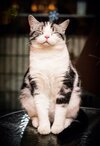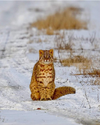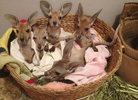You are using an out of date browser. It may not display this or other websites correctly.
You should upgrade or use an alternative browser.
You should upgrade or use an alternative browser.
Photos and videos of our amazing 2D residents
- Thread starter Bosphorus1982
- Start date
This is so beautiful to watch!
A rescued baby kangaroo.
Not the same kangaroo, but this little one wasn’t letting go of his teddy bear.
Not the same kangaroo, but this little one wasn’t letting go of his teddy bear.
"What's for breakfast," the little pig asks and is told "bacon."
FUN FACTS ABOUT CATS
1. Normal cats have a total of 18 toes, with five toes on each fore paw, and four toes on each hind paw; polydactyl cats may have as many as nine digits on their front or hind paws. (Are there normal cats? )
)
2. A cat's tongue has small bumps called papillae ("spines"), which help clean its fur.
3. The International Cat Association of the United States recognizes 73 breeds of cats
male and female
4. Cats can make more than 100 different types of sounds, while dogs can only make about 10.
5. A cat's purr not only indicates contentment, but it may also have healing properties for them.
6. Cats have excellent night vision and can see in only one-sixth of the light a human would need.
7. The average domestic cat sleeps about 12 to 16 hours a day.
8. Cats use their whiskers to measure spaces. If its whiskers fit in one place, they fit in too.
9. The smallest wild cat in the world is the rusty cat.
10. Ancient Egypt had great respect for cats, considering them sacred animals.
11. The body temperature of an adult cat is approximately 38.6 °C.
12. The average duration of a pregnancy in cats is about 63 days.
13. Although cats are known for being independent, they also seek affection and company.
14. Cats are able to remember their own names and those of others (including humans).
15. Some cats have a predilection for herbs such as catnip, which can lead to playful and euphoric behavior.

1. Normal cats have a total of 18 toes, with five toes on each fore paw, and four toes on each hind paw; polydactyl cats may have as many as nine digits on their front or hind paws. (Are there normal cats?
 )
) 2. A cat's tongue has small bumps called papillae ("spines"), which help clean its fur.
3. The International Cat Association of the United States recognizes 73 breeds of cats
male and female
4. Cats can make more than 100 different types of sounds, while dogs can only make about 10.
5. A cat's purr not only indicates contentment, but it may also have healing properties for them.
6. Cats have excellent night vision and can see in only one-sixth of the light a human would need.
7. The average domestic cat sleeps about 12 to 16 hours a day.
8. Cats use their whiskers to measure spaces. If its whiskers fit in one place, they fit in too.
9. The smallest wild cat in the world is the rusty cat.
10. Ancient Egypt had great respect for cats, considering them sacred animals.
11. The body temperature of an adult cat is approximately 38.6 °C.
12. The average duration of a pregnancy in cats is about 63 days.
13. Although cats are known for being independent, they also seek affection and company.
14. Cats are able to remember their own names and those of others (including humans).
15. Some cats have a predilection for herbs such as catnip, which can lead to playful and euphoric behavior.

Prionailurus bengalensis which is also called "leopard cat". He lives in Asia.
Prionailurus bengalensis que l'on appelle aussi "chat léopard". Il vit en Asie.

Kangaroo - Adorable JoeysKangaroo joeys are born tiny, comparable in size to a grain of rice or a small bee (5mm - 25mm). Upon birth, instinctively, the newborn kangaroo knows to crawl into its mother's pouch, experiencing warmth and affection for a few months before venturing out to explore the world on its own.

Kangourou - Adorables JoeysLes bébés kangourous naissent minuscules, comparables en taille à un grain de riz ou à une petite abeille (5 mm à 25 mm). Dès sa naissance, instinctivement, le nouveau-né kangourou sait se glisser dans la poche de sa mère, ressentant chaleur et affection pendant quelques mois avant de s'aventurer seul à explorer le monde.
Prionailurus bengalensis que l'on appelle aussi "chat léopard". Il vit en Asie.

Kangaroo - Adorable JoeysKangaroo joeys are born tiny, comparable in size to a grain of rice or a small bee (5mm - 25mm). Upon birth, instinctively, the newborn kangaroo knows to crawl into its mother's pouch, experiencing warmth and affection for a few months before venturing out to explore the world on its own.

Kangourou - Adorables JoeysLes bébés kangourous naissent minuscules, comparables en taille à un grain de riz ou à une petite abeille (5 mm à 25 mm). Dès sa naissance, instinctivement, le nouveau-né kangourou sait se glisser dans la poche de sa mère, ressentant chaleur et affection pendant quelques mois avant de s'aventurer seul à explorer le monde.
thank you, the kangourou babies are much more kind to their mothers: instead of blowing up a womans belly to incredible size and making birth painful, they rapidly fit in the shopping bag of mama. the creator of kangus had the mother's welfare in mind, but yaweh, woman's creator, made sure that even human reproduction was painful. i repeat, yaweh was/is a lizard... and one might infer what/who his creatures are...Prionailurus bengalensis which is also called "leopard cat". He lives in Asia.
Prionailurus bengalensis que l'on appelle aussi "chat léopard". Il vit en Asie.
View attachment 86623
Kangaroo - Adorable JoeysKangaroo joeys are born tiny, comparable in size to a grain of rice or a small bee (5mm - 25mm). Upon birth, instinctively, the newborn kangaroo knows to crawl into its mother's pouch, experiencing warmth and affection for a few months before venturing out to explore the world on its own.
View attachment 86624
Kangourou - Adorables JoeysLes bébés kangourous naissent minuscules, comparables en taille à un grain de riz ou à une petite abeille (5 mm à 25 mm). Dès sa naissance, instinctivement, le nouveau-né kangourou sait se glisser dans la poche de sa mère, ressentant chaleur et affection pendant quelques mois avant de s'aventurer seul à explorer le monde.
that's why cats have seven lives...
Pearl gene - Wikipedia
The Pearl gene, also known as the "Barlink factor", is a dilution gene at the same locus as the cream gene, which somewhat resembles the cream gene and the champagne gene but is unrelated to champagne. It is a somewhat rare dilution gene found in the American Quarter Horse, American Paint Horse, and Peruvian Paso.[2][3] The same mutation appears in Iberian horse breeds such as the Lusitano and Andalusian. The existence of the pearl gene in Quarter Horses and Paints is probably because these breeds have some Iberian ancestors.[2]
It is a recessive gene. If there is only one copy of the gene, it has no effect on black, bay or chestnut horses. If there are two copies, it lightens red coats to a pale, uniform apricot color that includes body, mane and tail and creates pale skin.[2] Because of this effect, when research was underway to locate the specific gene involved, it was at one time referred to as the "apricot" gene.[4]
The Pearl gene is also known to interact with the cream gene to enhance its effects and, in horses with only one copy of the cream allele, to create "pseudo-double dilutes" sometimes called pseudo-cremellos or pseudo-smoky cream. A pseudo-double dilute will often have pale skin and blue or green eyes.[2] Unlike the double cream dilute and the Pearl-cream pseudo dilute the double Pearl dilute typically has dark tan eyes. It is difficult if not impossible to tell a double cream dilute from a Pearl-cream pseudo dilute without genetic testing. Pearl is found at SLC45A2 (also called MATP), the same locus as cream, sunshine, and snowdrop.[5][6][7]
In the American Paint Horse breed, the dilution was called the "Barlink factor" because it was linked to a mare named My Tontime,[8] and her grandson, the stallion Barlink Macho Man, a chestnut splashed white.[9] Initially, the gene in Paints and Quarter Horses was thought to be a different allele than that in the Iberian breeds, but research demonstrated that it was the same gene.[2]
